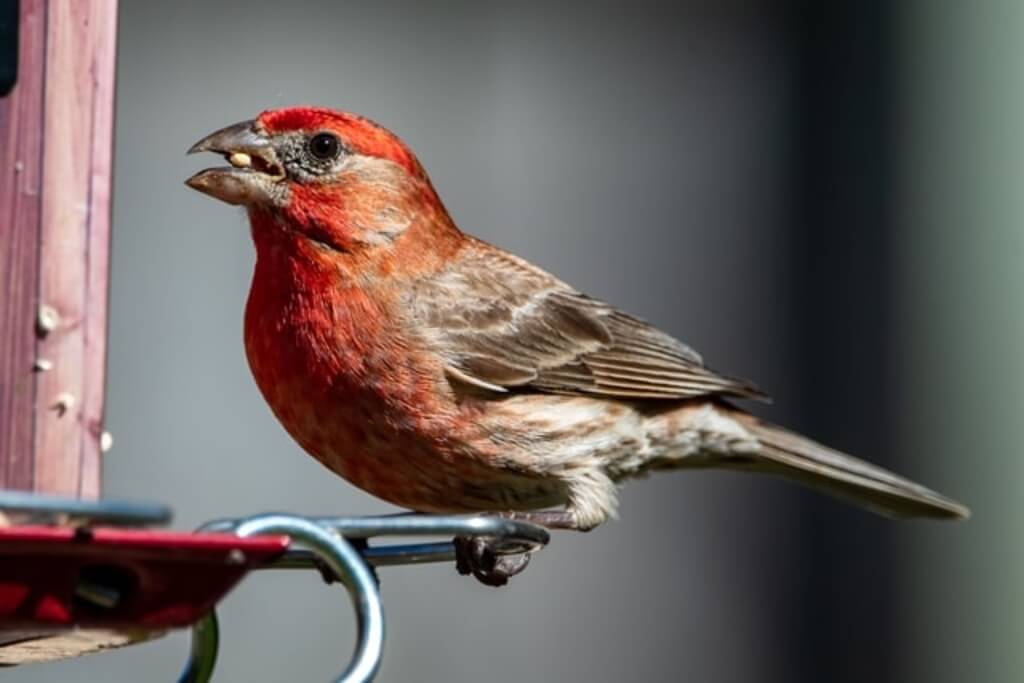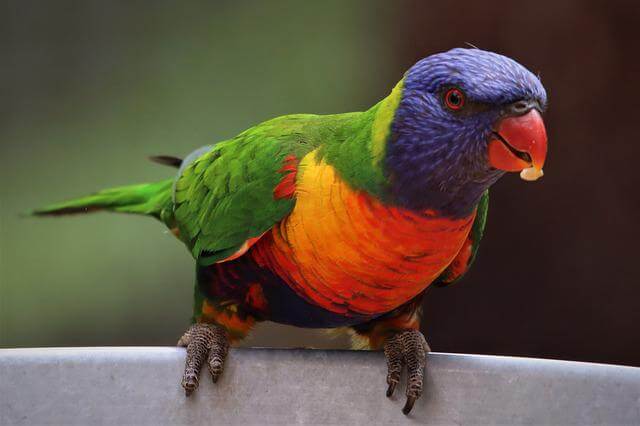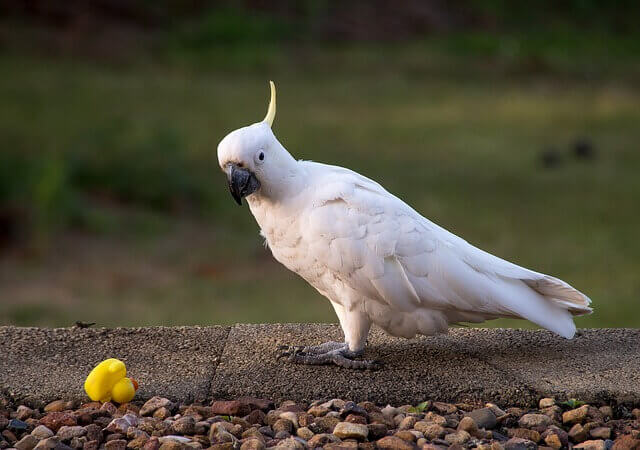Are you a fan of autumn bird feeding? If so, get ready for a treat! Step into the realm of fall birdwatching, where we unveil 29 birds that eat pumpkin seeds. This article is your gateway to not only discovering these feathered friends, but also mastering the art of pumpkin seed feeding.
Through captivating photos and detailed identifications, you’ll embark on an exciting journey through the avian kingdom and learn the secrets of providing these seeds in the best way.
Table of Contents
- 1 Benefits of Pumpkin Seeds for Birds
- 2 Birds That Eat Pumpkin Seeds
- 2.1 Black-capped Chickadee
- 2.2 Carolina Chickadee
- 2.3 Blue Jay
- 2.4 Eurasian Jay
- 2.5 California Scrub Jay
- 2.6 Steller’s Jay
- 2.7 Canada Jay
- 2.8 Blue Tit
- 2.9 Brown Thrasher
- 2.10 Dark-eyed Junco
- 2.11 European Starling
- 2.12 Gray Catbird
- 2.13 Great Tit
- 2.14 House Sparrow
- 2.15 Mourning Dove
- 2.16 Northern Cardinal
- 2.17 Northern Mockingbird
- 2.18 Purple Finch
- 2.19 Cassin’s Finch
- 2.20 House Finch
- 2.21 Rainbow Lorikeet
- 2.22 Rose-breasted Grosbeak
- 2.23 Evening Grosbeak
- 2.24 Sulfur-crested Cockatoo
- 2.25 Tufted Titmouse
- 2.26 Varied Tit
- 2.27 White-breasted Nuthatch
- 2.28 Red-breasted Nuthatch
- 2.29 Parrots
- 3 Preparing Pumpkin Seeds for Birds
- 4 Feeding Pumpkin Seeds to Birds
- 5 Author
Benefits of Pumpkin Seeds for Birds
The Nutritional Powerhouse of Pumpkin Seeds for Birds
Pumpkin seeds, often discarded as kitchen waste, hold a hidden treasure for your backyard’s feathered inhabitants. These unassuming seeds are a nutritional powerhouse that can provide essential sustenance to birds, particularly when they need it most.
Pumpkin seeds are like nature’s energy bars for birds, especially during the fall season when avian travelers are gearing up for migration and preparing to face the challenges of winter. These seeds offer a rich combination of calories, carbohydrates, healthy fats, and protein – everything birds require to fuel their demanding lifestyles.
But that’s not all. Pumpkin seeds are also a goldmine of vital trace minerals and nutrients, enhancing the overall health of your wild avian friends. Here’s a closer look at the nutritional content of these humble seeds:
| Nutrient | Benefits for Birds |
|---|---|
| Calories | Provides energy for long flights. |
| Carbohydrates | Serves as a quick energy source. |
| Healthy Fats | Aids in insulation and warmth. |
| Protein | Supports muscle development. |
| Calcium | Essential for strong eggshells. |
| Copper | Supports feather pigmentation. |
| Iron | Important for oxygen transport. |
| Magnesium | Aids in metabolism and muscle function. |
| Manganese | Contributes to bone health. |
| Phosphorus | Critical for overall growth and health. |
| Potassium | Helps in maintaining electrolyte balance. |
| Zinc | Supports immune system and wound healing. |
These nutritional elements are crucial for the well-being and vitality of wild birds, especially during demanding seasons. By offering pumpkin seeds in your backyard, you’re not only providing a tasty treat but also a nutritious boost that can make a real difference in the lives of your avian visitors.
So, the next time you carve a pumpkin for Halloween or cook a delicious pumpkin dish, remember to save those seeds. They might just become a lifeline for the birds that grace your backyard.
Birds That Eat Pumpkin Seeds
Black-capped Chickadee
Black-capped Chickadees are found in North America and are the most common chickadee. They can be found in a variety of habitats, including forests, parks, and gardens.
Black-capped Chickadees diet consists of insects, seeds, nuts, and berries. Pumpkin seeds are a favorite food of black-capped chickadees. They will also eat other seeds, such as sunflower seeds.
Related Posts:
- Best Bird Feeder For Chickadees (The Ultimate Guide 2022)
- Unique Black-Capped Chickadee Facts You Need To Know!
- How Do I Attract Chickadees To My Yard (Expert Tips)
- 13 Birds That Look Like Chickadees (Explained)
Carolina Chickadee
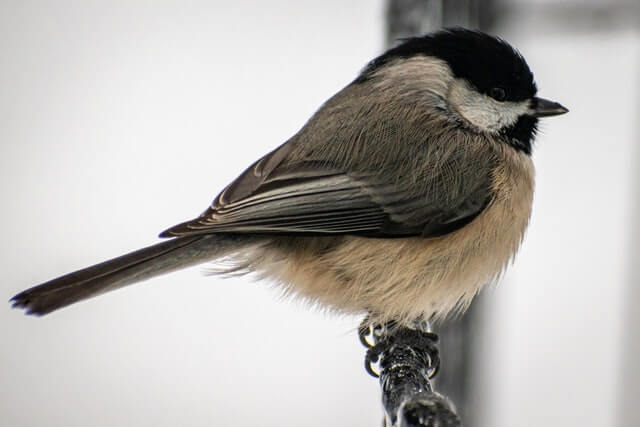
The Carolina Chickadee is a small, black and white bird that is found in the eastern United States. They range from Maine to Florida and west to Texas. The Carolina Chickadee prefers deciduous forests, but can also be found in open areas like fields and parks.
These birds eat mostly insects, but will also eat seeds, fruit, and nectar. Chickadees are not typically considered seed-eaters, but will occasionally feed on pumpkin seeds. In fact, one study found that chickadees were more likely to feed on pumpkin seeds when other food options were scarce.
Related Post: Carolina Chickadees – 9 Best Ways To Attract Them Fast!
Blue Jay

Blue Jays are commonly found in many parts of North America. They range from the southern United States to as far north as Alaska. They live in a variety of habitats, from forests to yards and parks. Blue Jays eat a variety of things, including insects, nuts, seeds and fruit.
Blue Jays will eat pumpkin seeds if they are available. They seem to especially like the hulls or shells of the seeds. This may be because the hulls are high in fiber and other nutrients. Pumpkin seeds are also a good source of protein, zinc and magnesium.
Related Posts:
- 15 Best Bird Feeders For Blue Jays (Tried & Tested 2022)
- What does a Blue Jay look like? Tips to identify them!
- What Attracts Blue Jays to your Yard?(Expert Tips)
- What Does A Blue Jay Eat? (10 Favorite Foods Revealed!)
- Do Blue Jays Migrate? The Truth
Eurasian Jay
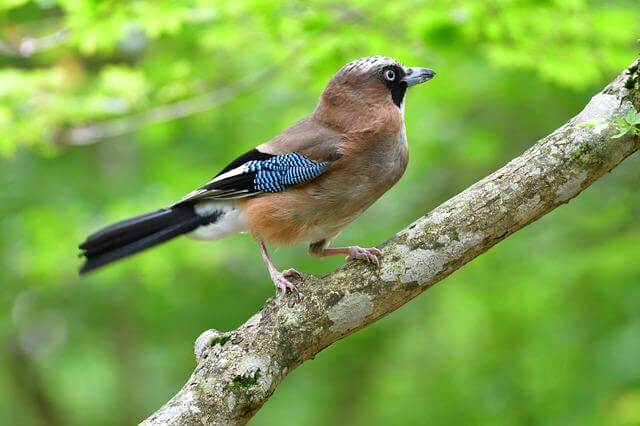
The Eurasian Jay is a member of the crow family and is found in Europe, Asia, and North America. They inhabit a wide range of habitats, from temperate forests to arid deserts. The diet of the Eurasian Jay consists mostly of insects, but they will also eat fruit, seeds, and small mammals.
Pumpkin seeds are a common food item for Eurasian Jays and they are known to cache these seeds in the ground for later consumption.
California Scrub Jay
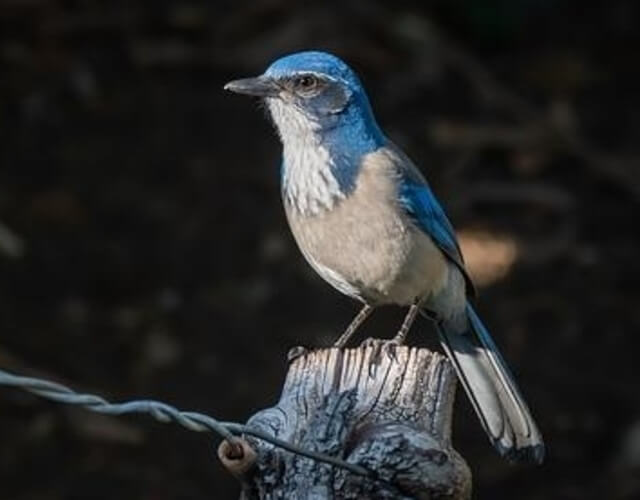
The California scrub jay (Aphelocoma californica) is a species of scrub jay native to western North America. It ranges from southern British Columbia in the north to Baja California and central Mexico in the south. The California scrub jay inhabits open woodlands, chaparral, and other dry habitats.
This bird is often seen in urban areas. The diet of the California scrub jay consists mainly of insects, nuts, seeds and berries. Pumpkin seeds are a common food item in the diet of the California scrub jay.
Steller’s Jay
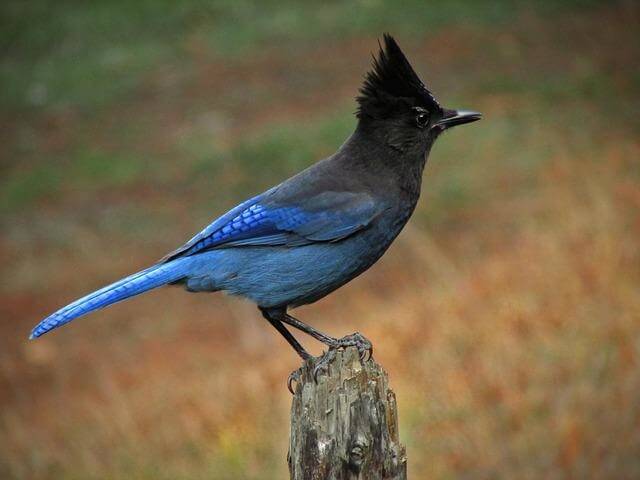
The Steller’s Jay is a North American bird that ranges from southern Alaska to central California. They live in coniferous forests and eat mostly insects, but will also eat fruit, seeds, and nuts.
One interesting fact about the Steller’s Jay is that they have been observed feeding pumpkin seeds to their young. It’s not clear why they do this, but it could be because the seeds are high in protein and fat.
Related Post: How to Attract Steller’s Jay to your Yard – Expert Tips!
Canada Jay

The Canada Jay is a crow-sized bird that is found in North America. They are common in the boreal forests of Canada and the United States. The Canada Jay has a blue-grey head, neck and back with a white throat and belly.
Their bill, legs and feet are black. These birds eat mostly insects, but also seeds, fruit and berries. In the fall, they will often feed on pumpkins seeds left behind by people at feeders.
Blue Tit
The blue tit is a small passerine bird that is found in Europe, Asia, and North Africa. The blue tit has a range extends from the British Isles and Scandinavia east to the Urals, and south to North Africa and the Mediterranean.
They inhabit deciduous woodlands, coniferous forests, gardens, parks, and orchards. Blue tit are omnivorous birds and eat a variety of food items such as insects, spiders, seeds, nuts, berries, and small amounts of meat. They have also been known to feed on pumpkin seeds.
Brown Thrasher
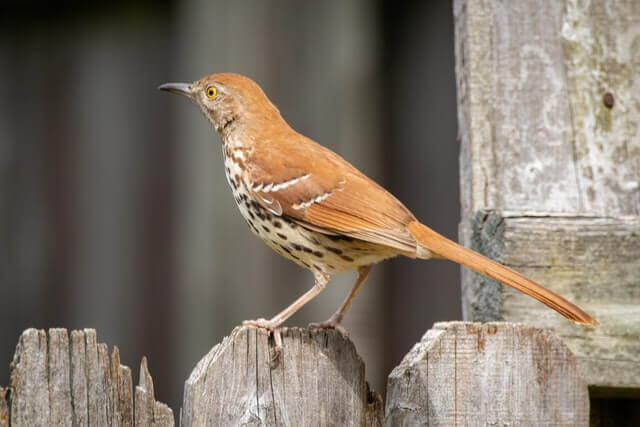
The Brown Thrasher is a bird that is found in the Eastern United States. They are usually seen in wooded areas, but can also be found in open fields. The Brown Thrasher diet consists of insects, such as beetles, caterpillars, grasshoppers and spiders.
They will also eat small rodents, lizards and snakes. In addition to these items, they will also eat fruit and seeds. Some people have reported seeing them eating pumpkin seeds.
Dark-eyed Junco
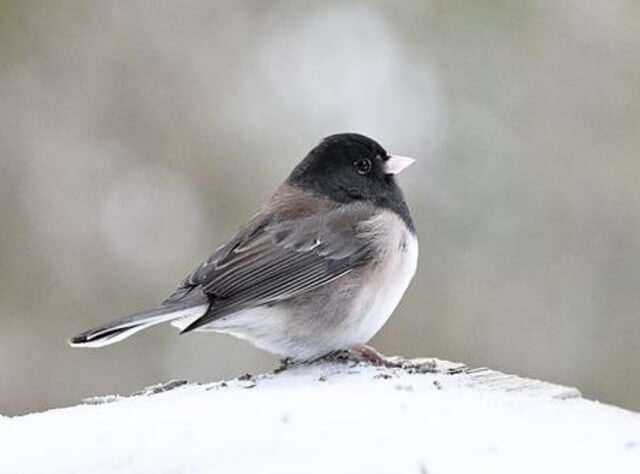
The Dark-eyed Junco (Junco hyemalis) is a small passerine bird that is found in North America. This species is widespread and can be found in many different habitats, including forests, meadows, and even urban areas.
The diet of the Dark-eyed Junco consists mostly of seeds, but they will also eat insects and other small invertebrates. In the fall, Dark-eyed Juncos often feed on pumpkin seeds, which are high in fat and protein.
Related Posts:
European Starling
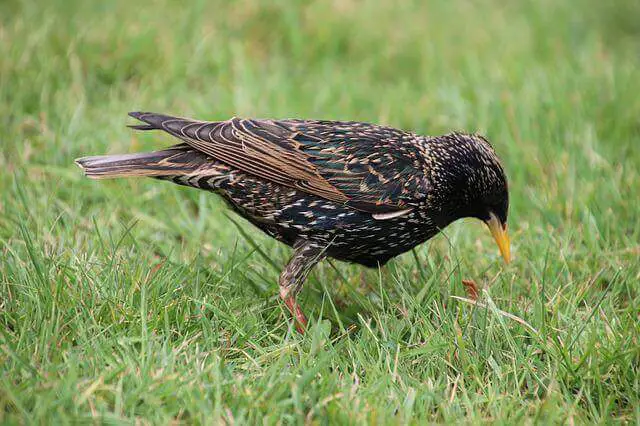
European starlings are a common sight in North America, but their range extends all the way to Europe and Asia. These birds are typically found in open habitats like fields, parks, and gardens, where they feed on insects, fruits, and seeds.
European starlings will also eat pumpkin seeds, and they can be seen raiding pumpkin patches during the fall harvest. These birds are known for their vocal songs, which can be heard throughout their range.
Related Post: How To Attract European Starlings To Your Yard Fast?
Gray Catbird
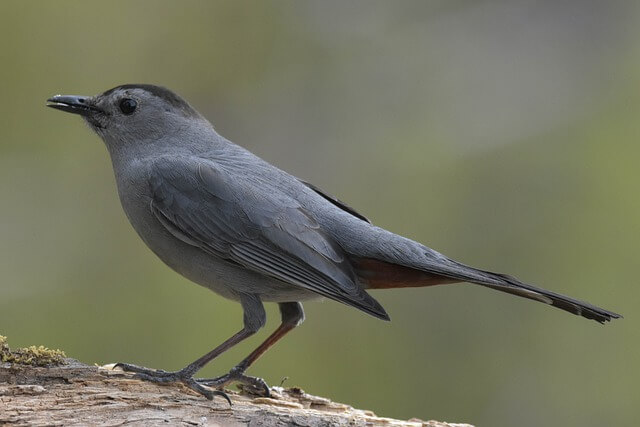
The Gray Catbird is a common New World bird that ranges from southern Canada to northern South America. In the United States, they can be found in most of the eastern states, as well as parts of the Midwest and west coast.
The catbird’s preferred habitat is dense thickets near water, but they can also be found in gardens, orchards and other open areas. They are primarily insectivores, but will also eat fruit and seeds. It has been known that they also enjoy eating pumpkin seeds.
Great Tit

The great tit is a widespread and common European bird that can be found in a variety of habitats, including forests, gardens and parks. Great tit are omnivorous and eat a variety of items in their diet, which includes insects, spiders, seeds and nuts.
In the fall, the great tit will also feed on pumpkin seeds. Pumpkin seeds and pumpkin skin are a good source of protein and fat for birds and help them to store energy for the winter.
House Sparrow
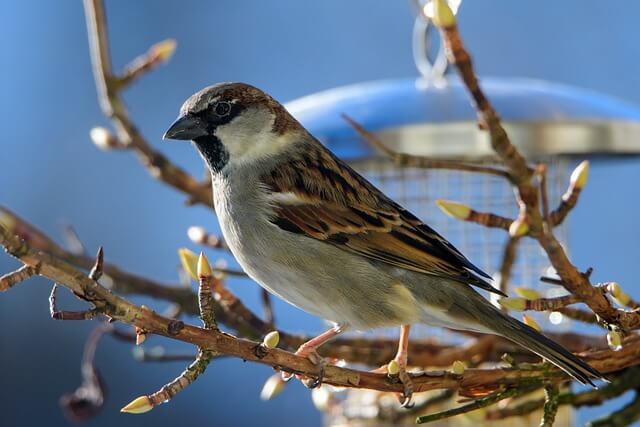
House Sparrows are common in North America and can be found in a variety of habitats, including gardens, parks, and farms. These birds eat mostly seeds, but they will also consume insects, fruit, and other items.
House Sparrows often feed on the ground, but they may also perch on trees or buildings. Pumpkin seeds are a popular food item for House Sparrows, and they will often store large quantities of them in their nests.
Related Posts:
- How to Attract Sparrows to your Backyard? (Like A Pro)
- Birds That Look Like Sparrows: 16 Most Common Types!
Mourning Dove
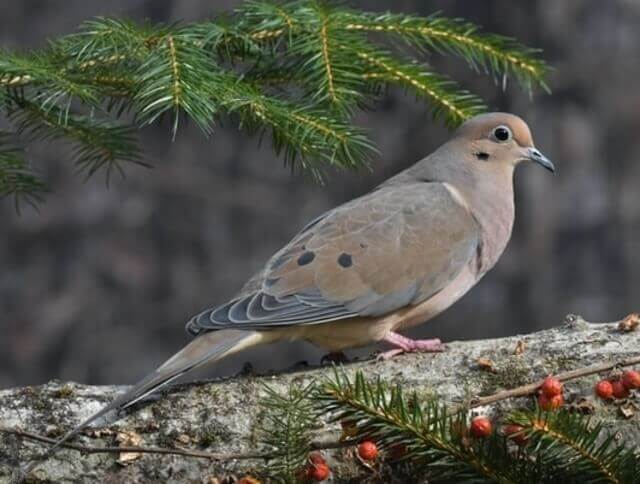
The mourning dove is a bird that can be found in open woodlands, agricultural areas, and suburban neighborhoods across the United States. Mourning doves prefer to live in habitats with dense understory vegetation and scattered trees for perching.
These birds are omnivorous and feed on a variety of seeds, fruits, and insects. Mourning doves are not typically known to eat pumpkin seeds, but they will consume them if they are readily available in feeders.
Related Posts:
- Facts About Mourning Doves – 10 Things You Need To Know!
- Can Birds Move Their Eggs To Another Nest? (Is It True?)
Northern Cardinal
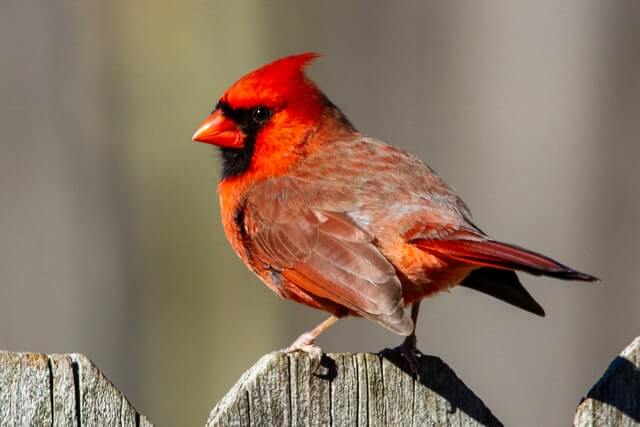
The Northern Cardinal is a North American bird that is found in deciduous forests, open woodlands and gardens. Cardinals are very versatile in their choice of habitats and can be found from southern Canada to northern Mexico. They are also common in many suburban and urban areas.
Cardinals are seed eaters and their diet includes a variety of seeds from different plants. They will also eat insects, fruit and pumpkin seeds if they are available.Cardinals usually nest in dense shrubs or trees, but sometimes they will build their nests in hanging flower baskets or on top of porch roofs.
Northern Mockingbird
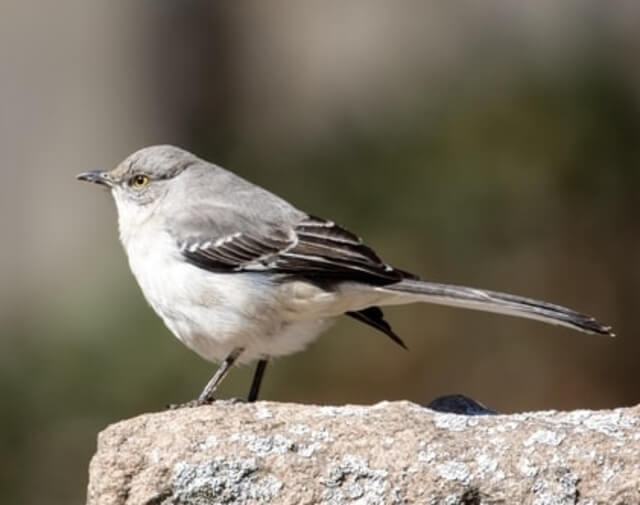
The Northern Mockingbird is found in a variety of habitats in the United States and parts of Canada. They live in open areas near water such as wetlands, meadows, and prairies. They can also be found in urban areas near gardens and parks.
The diet of the Northern Mockingbird consists mainly of insects, but they will also eat fruit, seeds, and other small animals. Pumpkin seeds are a favorite food of the Northern Mockingbird.
Purple Finch
The Purple Finch is a North American bird that is found in open woodlands, gardens and parks. They are about 5-6 inches in length and have a reddish brown back with a white belly.
The males are easily distinguishable by their bright purple chest and head. These birds eat mostly seeds but will also consume insects, fruit and nectar. In the fall, they love to feast on pumpkin seeds!
Cassin’s Finch

Cassin’s Finch is a small North American bird that inhabits open woodlands and prairies. They are omnivorous and eat a variety of seeds, fruits, and insects. Pumpkin seeds are a favorite food for Cassin’s Finch and they can be found at many bird feeders eating them.
These birds have a wide range and can be found from Alaska to Mexico. They prefer habitats with some trees but also open areas for foraging.
House Finch
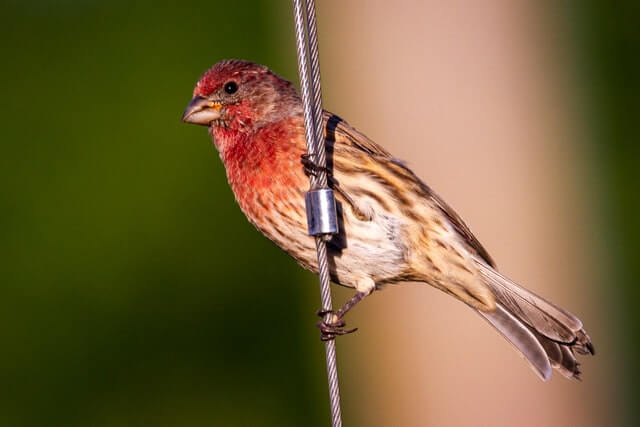
The house finch is a small North American bird that is commonly found in residential areas. The house finch has a wide range that extends from Alaska to Central America. In the United States, this species is most commonly found in the Western states, but they can also be found in the Northeast and parts of the Southeast.
The house finch prefers habitats that have trees or shrubs for cover and where there is an abundance of food sources.The house finch feeds on seeds, fruits, and insects. These birds eat a variety of seeds, but their favorite food is sunflower seeds.
Rainbow Lorikeet
Rainbow Lorikeets (Trichoglossus haematodus) are native to Australia and can be found in woodlands, gardens, parks and near water. They are typically around 10-12 inches in length and have a bright green body with a red breast and blue head. These birds are very social and playful, making them popular as pets.
Rainbow Lorikeets eat mainly nectar and fruits, but will also eat insects, seeds and flowers. Pumpkin seeds are a favorite food of these birds and can be easily added to their diet by scattering them on the ground or in a feeder.
Rose-breasted Grosbeak
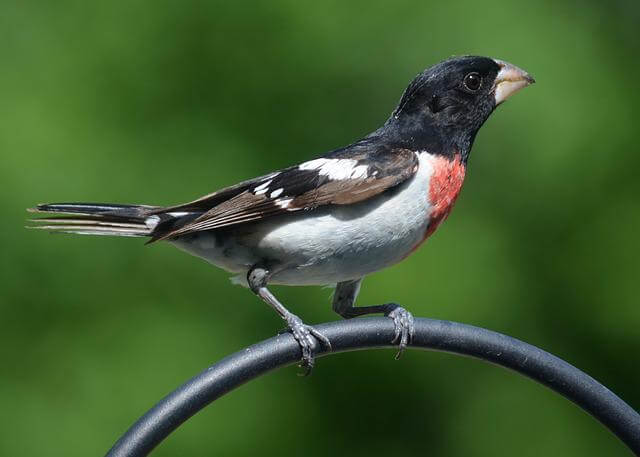
The Rose-breasted Grosbeak is a songbird that is found in North America. This bird can be found in a variety of habitats, such as forests, woodlands, and parks.
The Rose-breasted Grosbeak diet consists mostly of insects and seeds. Pumpkin seeds are a favorite food of this bird and they will often feast on them during the fall months.
Evening Grosbeak

The Evening Grosbeak is a North American bird that is typically found in open woodlands and along forest edges. They are also known to inhabit parks and gardens in urban areas.
These birds primarily eat seeds, but they will also consume insects and fruit. Pumpkin seeds are a favorite food of the Evening Grosbeak, and they will often visit pumpkin patches to feed on the seeds.
Sulfur-crested Cockatoo
The sulfur-crested cockatoo is a large, white parrot found in woodlands and rainforests of Australia and New Guinea. These birds are around 20 inches in length and have a wingspan of up to 39 inches. They weigh around 1.7 pounds. The males and females look very similar, but the male has a slightly larger crest.
Sulfur-crested cockatoos live in a wide range of habitats, from rainforest to open woodland, but they are not found in dense forest. They need trees for nesting and roosting, as well as foraging. They also need areas with plenty of grasses and other ground cover for feeding. These birds mainly eat seeds, nuts, fruits, and insects. Sulfur-crested cockatoos also enjoy eating pumpkin seeds.
Tufted Titmouse
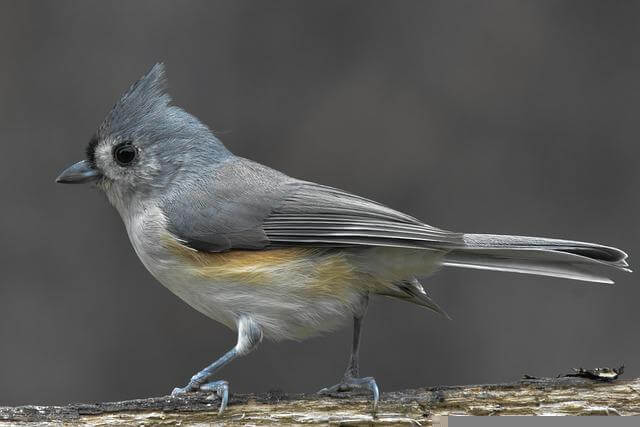
Tufted Titmice are small North American birds that can be found in a variety of habitats, including forests, woodlands, and gardens. These birds are omnivores and eat both plant material and animals.
Tufted Titmice enjoy eating pumpkin seeds and other seeds from plants such as sunflowers. They also eat insects, spiders, and other small animals.
Varied Tit

The Varied Tit is a small songbird that can be found in North America and Europe. They have a black cap and nape, white cheeks, and a gray back. Their underparts are light-colored and they have a dark stripe through their eye.
These birds are insectivores and eat seeds, berries, and insects. They will also eat pumpkin seeds if they are available. Varied Tit live in forests, gardens, and parks. They are cavity nesters and will build their nests in trees or birdhouses. These birds are monogamous, and the male helps care for the young.
White-breasted Nuthatch
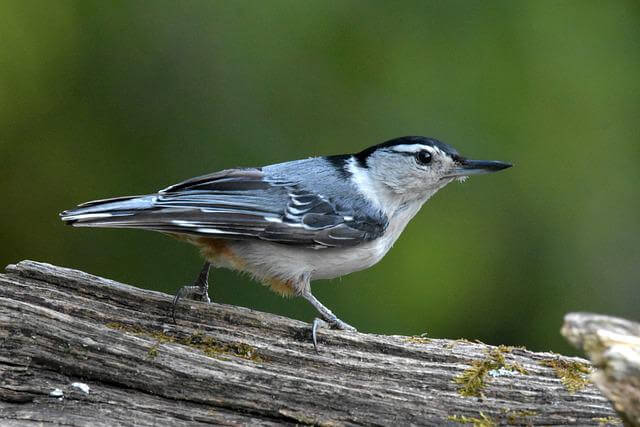
The White-breasted Nuthatch is a small songbird that can be found in North America. These birds prefer to live in coniferous forests and make their homes in tree cavities. They eat both plants and animals, making them omnivorous.
Their diet consists of insects, nuts, seeds, and fruit. One of their favorite foods is the pumpkin seed. They will often search for these seeds on the ground or pick them up from bird feeders. White-breasted Nuthatches are known for their acrobatic behavior as they move up and down tree trunks searching for food.
Red-breasted Nuthatch
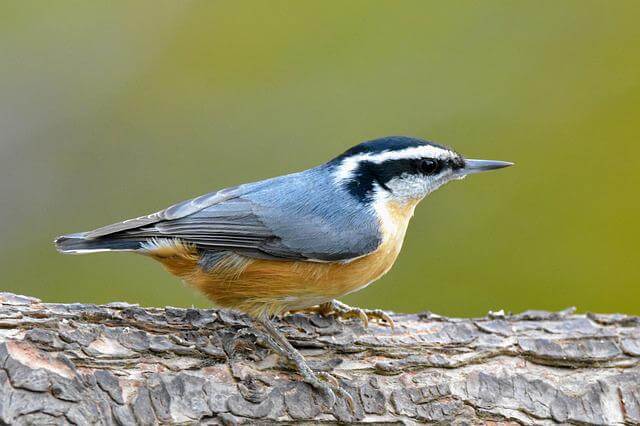
The Red-breasted Nuthatch is a small passerine bird that is found in North America. This species ranges from southeastern Alaska to Central America, and can also be found in parts of the Caribbean. The Red-breasted Nuthatch inhabits coniferous and mixed forests, as well as woodlands and orchards.
This bird feeds mostly on insects, but will also consume seeds, nuts, and fruit. In the fall, they often visit backyards to eat the leftover pumpkins seeds.
Parrots
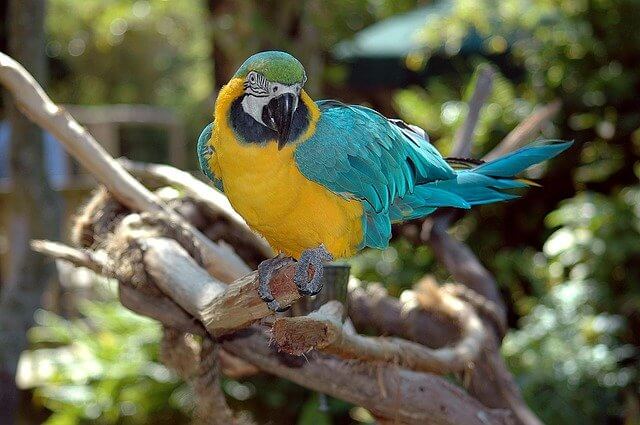
Sunflower seeds are a popular treat for many types of birds, and parrots are no exception. In fact, sunflower seeds may be one of the bird’s favorite snacks. There are several ways to give your parrot these seeds. One is to put them in a mesh feeder that hangs from a tree or from the side of your house.
Another option is to spread the seeds on the ground in an open area where your bird can fly down and eat them. You can also offer sunflower seeds as part of your bird’s regular diet. If you do this, make sure to give your parrot other foods as well, so they get the nutrients they need.
Preparing Pumpkin Seeds for Birds
Offering pumpkin seeds to our feathered friends is a straightforward and rewarding endeavor. Whether you prefer minimal effort or enjoy a bit of culinary flair, there’s a method that suits your style.
The Effortless Approach: Raw Seeds For those who want simplicity, look no further than the raw seeds. After scooping them from the pumpkin’s interior, place them directly into a dish or tray feeder. Birds will eagerly help themselves, nibbling on the seeds and picking off bits of flesh. In some cases, they may even venture to a compost heap, drawn by the allure of juicy rind and crunchy seeds.
The Culinary Touch: Roasting Pumpkin Seeds For a slightly more involved approach, you can roast the seeds to enhance their appeal. Begin by rinsing the seeds in clean water to remove excess pulp. Next, arrange the cleaned seeds in a thin layer on a lightly greased or non-stick tray or cookie sheet. Roast them at a gentle 200 to 300 degrees Fahrenheit (95 to 150 degrees Celsius) for about 20 to 30 minutes. Be vigilant, occasionally turning or stirring the seeds to prevent any mishaps like burning or scorching. Once done, allow the seeds to cool completely before handling.
Embracing the Sun: Air-Drying Pumpkin Seeds If you prefer an entirely natural approach, consider air-drying the pumpkin seeds. Lay them out on a screen or tray outdoors on a sunny day. Position the seeds in direct sunlight for several hours, ensuring to stir or turn them every hour or two for even drying. If there’s a gentle breeze, it will expedite the drying process.
A Note of Caution: Avoid Harmful Additives While pumpkin seeds in their raw, dried, or roasted forms are excellent for birds, exercise caution and refrain from offering seeds with salt, seasonings, candy coatings, or any flavorings. These additives are detrimental to birds and may invite less desirable guests like rodents. Also, keep in mind that pumpkin-based baked goods, such as bread, pies, cookies, muffins, or donuts, should not be on the avian menu.
Feeding Pumpkin Seeds to Birds
Once your pumpkin seeds are prepared, you have multiple options for serving them to your backyard birds. You can add them whole to a bird feeder or crush them with a rolling pin or coarsely grind them in a food processor.
Breaking the seeds into smaller pieces makes them more enticing for smaller bird species that may struggle with the size and firm hulls of whole seeds. Given their size, consider using feeders with wide feeding ports, open feeding trays, or dishes to ensure birds can access the seeds easily.
Alternatively, scattering the seeds directly on the ground, deck, patio, or railing can attract hungry birds. Whole or crushed pumpkin seeds can also be incorporated into homemade suet or blended with other birdseed mixtures.
Additionally, you can string whole seeds onto a bird feeder garland or arrange them in patterns on homemade birdseed ornaments for festive feeding options.
Be patient, as it may take a little time for birds to discover the delights of pumpkin seeds. To entice them, sprinkle a few black oil sunflower seeds on top of a handful of pumpkin seeds.
Reducing or removing other types of birdseed and foods offered can also encourage birds to give pumpkin seeds a try. Once they become acquainted with this autumnal feast, many birds will eagerly partake in this seasonal delight.
Related Post: 22 Birds That Eat Sunflower Seeds (with Photos & Details)
Sources:
- So You’ve Got an Old Pumpkin to Get Rid Of. The Ohio State University.
- Burt SA, Vos CJ, Buijs JA, Corbee RJ. Nutritional Implications of Feeding Free-living Birds in Public Urban Areas. J Anim Physiol Anim Nutr (Berl). 2021;105(2):385-393. doi:10.1111/jpn.13441

